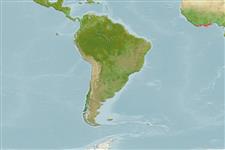Elasmobranchii (sharks and rays) >
Myliobatiformes (Stingrays) >
Zanobatidae (Panrays)
Etymology: maculatus: Name from Latin 'macula' for spotted; referring to its blotched colour pattern.
Environment: milieu / climate zone / depth range / distribution range
Ecology
Marine; demersal; depth range 1 - 30 m (Ref. 116736). Tropical; 6°N - 5°S, 8°W - 11°E (Ref. 114953)
Distribution
Countries | FAO areas | Ecosystems | Occurrences | Point map | Introductions | Faunafri
Eastern Central Atlantic: Gulf of Guinea, from Ivory Coast to Gabon.
Size / Weight / Age
Maturity: Lm ? range ? - ? cm
Max length : 35.9 cm TL male/unsexed; (Ref. 116736)
Short description
Identification keys | Morphology | Morphometrics
This species is distinguished from its congener (Zanobatus schoenleinii) by the following combination of characters: dorsal surface of disc is brownish to reddish brown, with numerous dark brown blotches, and sometimes surrounded by a network of whitish dots; the ventral surface of disc is pale creamy white or orange-brown, with conspicuous dark brown posterolateral margins; the crown of dermal denticles of dorsal surface spearhead-shaped; dorsal surface with enlarged thorny denticles are more numerous and stronger, in parallel rows on trunk and in concentric semi-circular rows on pectoral fins; tooth rows in upper jaw 54-64 ; predorsal vertebrae 36-44 (mode 39) (Ref. 116736).
Lives mostly on sandy bottoms (Ref. 116736).
Life cycle and mating behavior
Maturity | Reproduction | Spawning | Eggs | Fecundity | Larvae
Séret, B., 2016. Zanobatus maculatus, a new species of panray from the Gulf of Guinea, eastern central Atlantic (Elasmobranchii: Batoidea: Zanobatidae). Zootaxa 4161(4):509-522. (Ref. 116736)
IUCN Red List Status (Ref. 130435: Version 2024-2)
Threat to humans
Harmless
Human uses
Tools
Special reports
Download XML
Internet sources
Estimates based on models
Phylogenetic diversity index (Ref.
82804): PD
50 = 0.7500 [Uniqueness, from 0.5 = low to 2.0 = high].
Bayesian length-weight: a=0.01000 (0.00244 - 0.04107), b=3.04 (2.81 - 3.27), in cm total length, based on all LWR estimates for this body shape (Ref.
93245).
Trophic level (Ref.
69278): 3.4 ±0.5 se; based on size and trophs of closest relatives
Fishing Vulnerability (Ref.
59153): Low to moderate vulnerability (26 of 100).
